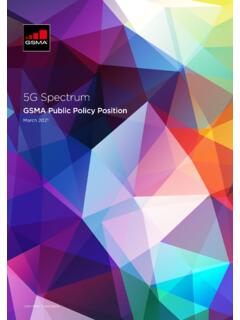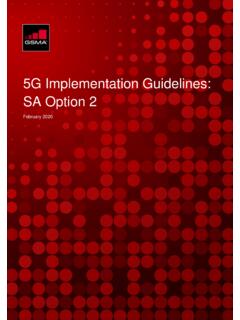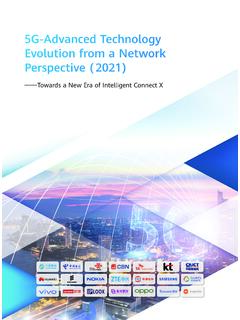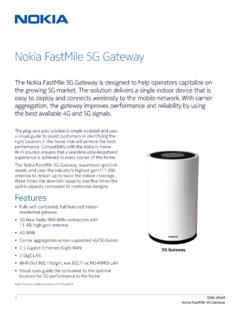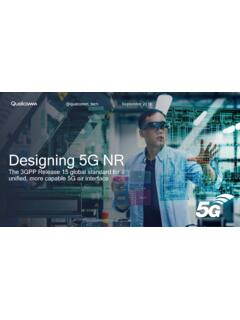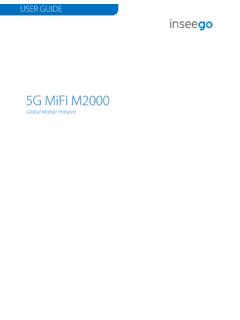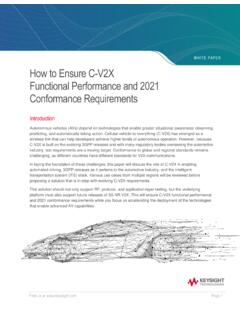Transcription of 5G Network Evolution with AWS
1 5G Network Evolution with AWS Design scalable, secure, reliable, and cost-efficient cloud-native core and edge Network on AWS July 2020 Notices Customers are responsible for making their own independent assessment of the information in this document. This document: (a) is for informational purposes only, (b) represents current AWS product offerings and practices, which are subject to change without notice, and (c) does not create any commitments or assurances from AWS and its affiliates, suppliers or licensors. AWS products or services are provided as is without warranties, representations, or conditions of any kind, whether express or implied. The responsibilities and liabilities of AWS to its customers are controlled by AWS agreements, and this document is not part of, nor does it modify, any agreement between AWS and its customers. 2020 Amazon Web Services, Inc. or its affiliates. All rights reserved. Contents Introduction .. 1 AWS and 1 Building blocks of AWS services for 5G Network implementation.
2 2 Cloud-native core Network Evolution with AWS .. 3 5G SA core characteristics and feature parity with AWS Services .. 4 5G Non-standalone (NSA) core and standalone (SA) core .. 7 Design considerations of cloud-native 5G SA core on AWS .. 8 Reference architecture of 5g Core based on AWS Well-Architected Framework .. 17 Radio Access Network Evolution with AWS .. 25 Control and user plane separation (CUPS) .. 25 Network slicing .. 26 Multi-access edge computing on AWS .. 26 Wavelength .. 27 MEC on AWS .. 28 Orchestration and automation in AWS .. 30 Management and orchestration .. 30 AWS native management and orchestration .. 31 Automation and DevOps .. 33 Private/Local 5G Network use case .. 39 Conclusion .. 41 Contributors .. 41 Document 42 Glossary .. 42 Abstract 5G is transforming the connectivity landscape, allowing lower latency and higher bandwidth across a larger scale of devices. Setting up and managing 5G mobile Network functions on AWS allows for global scalability, cost reduction, elasticity, and hundreds of augmenting features (for example, AI, Analytics, IoT, DevOps).
3 This paper highlights the best practices for designing and deploying 5G mobile Network functions on AWS. Amazon Web Services 5G Network Evolution with AWS 1 Introduction The advent of 5g brings dramatic improvements to both the radio access Network (RAN) and its core Network . Besides with the most important and significant change in the radio technology, such as using millimeter wave spectrum (mmWave) for better throughput of and less latency in data transmission, Network architectures of Core and RAN become to have an easier transition to the modern innovations of cloud-native software technologies such as microservices, containerized, service-based, and stateless architecture. For the Core Network aspect, 3 GPP1 defines 5G standalone (SA) Core Network to have decomposed architecture with the introduction of a service-based interface (SBI) using HTTP/2 as a baseline communication protocol, and control plane and user plane separation (CUPS). This function decomposition, SBI, and CUPS of 5g Network function software strongly favor cloud-native container-based implementation.
4 Even though 5G Network function can be built based on the legacy generation of architecture such as virtual machine (VM) based monolithic architecture, the real benefits in terms of agility, fast innovation, hyper scalability, elasticity, and simplified operations and lifecycle management (LCM) can be realized only when the 5G Network functions (NFs) are designed and implemented on a cloud-native container-based microservices architecture. In the case of RAN, decomposition of Central Unit (CU) and Distributed Unit (DU), the use of enhanced Common Public Radio Interface (eCPRI), and Open RAN (O-RAN) concept make traditional Baseband Unit (BBU) to be more easily transformed to a virtualized Network function or containerized Network function. This can bring the benefit of scalability and cost-efficiency in terms of both, operating expenditures and capital expenditure. AWS and 5G The transformation of both Core and RAN in the 5G era makes AWS an ideal platform for hosting them.
5 This is due to the breadth and depth of AWS services and an API-driven approach to designing modern, cloud-native applications. Additionally, the promise of Network slicing is expected to bloom in the 5G era, creating a private and enterprise-oriented Network . As such, the 5G Network would be best built on the hyper-scalable platform. Therefore, AWS becomes a natural choice for providing 5G Network creation, not only for its breadth and depth of services but also because of the strongest and widest partner ecosystem across Network equipment providers (NEP) and Amazon Web Services 5G Network Evolution with AWS 2 communication service provider (CSP) in the telecom industry. Openness has been a long-standing requirement of CSPs and AWS Cloud provides exactly that strong foundation for all NEPs to build and innovate on. This whitepaper describes a reference architecture of 5g on AWS to help CSPs and NEPs build a carrier-grade 5G production Network , in the wide spectrum of views such as design, deployment model, use cases, and AWS tools.
6 It focuses on achieving operational excellence and agility needed by CSPs leveraging AWS products and services for networking, compute, storage, DevOps, and CI/CD pipeline. It also discusses how CSPs can monetize its Network by building services using other AWS services like that for data lakes, IoT, and AI/ML. The paper lays out the typical deployment journey of 5g Evolution from using non-standalone (NSA) core, to a new standalone (SA) core Network and RAN. Specifically, how relevant AWS services are used for helping cloud-native microservices and stateless architecture-based NFs will be introduced with providing a reference architecture for 5G SA core Network that brings the benefit of hyper-scalability, reliability, unified programmable orchestration, and faster speed of innovation for a new service. Lastly, AWS has stretched its service coverage to the Edge cloud by using AWS Outposts, Local Zones, and Wavelength. This whitepaper highlights how these AWS services can contribute to building a seamless 5G Network with providing the best value, the most cost-saving, and the better monetization strategy to the service provider.
7 Building blocks of AWS services for 5G Network implementation 5G has stringent requirements to meet user demands. However, due to a mature and burgeoning set of features, 5G workloads can be deployed on Amazon Web Services (AWS) despite stringent service-level requirements while also benefiting from scalability, elasticity, and high availability. Today, several customers are using AWS, its partners, and open source solutions to run workloads with reduced cost, faster agility, the ability to go global in minutes, and rich features that AWS services offer. Customers use AWS features such as enhanced networking with an Elastic Network Adapter (ENA) and the latest generation of Amazon Elastic Compute Cloud (EC2) instances to get the following benefits: Data plane development kit (DPDK) Amazon Web Services 5G Network Evolution with AWS 3 Single root I/O virtualization (SR-IOV) Huge pages NVM Express (NVMe) Non-uniform memory access (NUMA) support Bare metal instances to meet RTC workload requirements These instances offer Network bandwidth of up to 100 Gbps and commensurate packets per second, delivering increased performance for Network intensive applications.
8 For scaling, Elastic Load Balancing offers Application Load Balancer, which offers WebSocket support and Network Load Balancer that can handle millions of requests per second. For Network acceleration, AWS Global Accelerator provides static IP addresses that act as a fixed entry point to your application endpoints in AWS. It has support for static IP addresses for the load balancer. For reduced latency, cost, and increased bandwidth throughput, AWS Direct Connect establishes dedicated Network connection from on-premises to AWS. Highly available managed SIP trunking is provided by Amazon Chime Voice Connector. Because the 5G Network aims to follow modern software architecture, it is expected to be built on microservice architecture. The most common design pattern in these days for microservice is using containers. AWS is the most preferred platform for developers to run their container-based microservice application. Today, 84% of Kubernetes workloads that run in the cloud are running on AWS.
9 This container-based microservice application can be empowered by many AWS services, including Amazon Elastic Kubernetes Service for managed Kubernetes service, App Mesh for service-mesh, and AWS Cloud Map for application resource discovery. Cloud-native core Network Evolution with AWS This section explains the 5G core Network Evolution , which is often mentioned as a cloud-native core Network . As illustrated in Figure 1, a cloud-native core offers the benefit of hyper-scalability, high availability, fast innovation, programmable orchestration and automation, and new business opportunity using Network slicing to CSP operators. Amazon Web Services 5G Network Evolution with AWS 4 This section will cover how these key benefits can be ensured and implemented in AWS environment. Figure 1 Cloud-native 5G Core and AWS services 5G SA core characteristics and feature parity with AWS Services This section describes key characteristics of 5g SA core before illustrating desirable architecture on AWS.
10 Then, we will map the most suitable AWS service for each of those characteristics. Amazon Web Services 5G Network Evolution with AWS 5 Figure 2 5G Characteristics and AWS feature parity Control and User Plane Separation 5G SA Core Network inherits control and user plane separation (CUPS) architecture from 3 GPP Release 14. In 4G, S/PGWs are de-composed to S/PGW-C and S/PGW-U to provide an efficiency for scaling of services independently. This decomposition continues to 5G and therefore User Plane Function (UPF) plays a role only on packet processing of user traffic, while all other singling processing is done by all other control functions such as Session Management Function (SMF). This CUPS architecture of 5g SA core can bring the benefit of cost-saving and scaling with making control plane to be centralized in the AWS Regions, while distributing UPF functions to the Edge data centers using AWS Outposts. Stateless architecture The 3 GPP standard has introduced stateless architecture for Network optimization and better reliability and resiliency.










